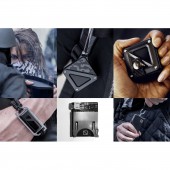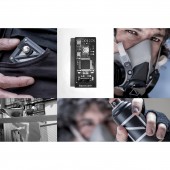Backslash Communication by Pedro Oliveira & Xuedi Chen |
Home > Winners > #41800 |
 |
|
||||
| DESIGN DETAILS | |||||
| DESIGN NAME: Backslash PRIMARY FUNCTION: Communication INSPIRATION: The future of technology in protest looks dark. The hyper-militarization of law enforcement has become widespread as global governments attempt to suppress dissent and monitor their citizens. There is a huge disparity between the amount of technologies used by the authorities and the technologies available to protesters and activists during protests and riots. The modern protester believes that connectivity is a basic human right. In protests of the future, how will the underground fight back? UNIQUE PROPERTIES / PROJECT DESCRIPTION: Backslash is a space to research the relationship between protests and technology, cultivating dialog about freedom of expression, riots and disruptive tech. The Backslash kit is a collection of functional devices designed and built to facilitate communication in areas of conflict. A fast deployment router, a wearable that can notify others blocks before entering a conflict area, or a way to keep your phone from being track and identified. This is just the start. OPERATION / FLOW / INTERACTION: The devices are designed for emergency situations, it is in their nature to be fast, effective and semi-disposable. The creators kept several things in mind like fast and easy deployment, safety of users, avoiding the collection of sensitive data, communication during network blackouts and ability in spreading messages and reaching the global community. The devices are all designed and programed to be quickly deployable with the pull of a switch or a push of a button. PROJECT DURATION AND LOCATION: The project was started in spring of 2015. It has been invited to present the project at the Open Hardware Summit and NYC Media Lab Summit in September. It will also be a part of the Radical Networks conference in October 2015. FITS BEST INTO CATEGORY: Idea and Conceptual Design |
PRODUCTION / REALIZATION TECHNOLOGY: The kit is a set of 6 hi-low tech devices that can enable alternative methods of communication in creative ways using accessible technologies. Open sourced designs were used to develop the electronics. Attention was paid to using low cost and easily accessible components. Enclosures for devices are modeled and 3D printed on the Objet Connex500 in multiple rigid and flexible materials. Enclosures were post processed and finished by hand. Additional details were laser cut and milled in aluminum. SPECIFICATIONS / TECHNICAL PROPERTIES: The devices range in sizes. Wearable: 20mm x 40mmm x 13mm SD: 50mm x 50mm x 15mm Jam: 50mm x 50mm x 15mm Router: 50mm x 50mm x 90mm Bandana: 510mm x 510mm Stencils: 100mm x 100mm x 30mm TAGS: communication, digital, privacy, security, social impact, protest, community driven design RESEARCH ABSTRACT: Research included developing creative and unconventional means of communication for dynamic situations. Protesters in the US and Hong Kong have more smart phones, making computer vision technologies more accessible. However this is not the case in some developing countries. A lot of research effort was put into finding low cost and accessible solutions in electronics and mode of production that would allow these devices to be built and used in different countries. CHALLENGE: Conditions vary immensely across the globe. A one size fits all solution to these dynamic situations is impractical. With this project, we highlight the significance of community driven design and the importance of inciting this discourse with the global community. By showing the possibilities that can be achieved by appropriating existing and accessible technologies, we hope to inspire communities to collectively redefine and reinvent their technological culture in protests. ADDED DATE: 2015-06-26 19:53:39 TEAM MEMBERS (2) : Pedro Oliveira and Xuedi Chen IMAGE CREDITS: Roy Rochlin |
||||
| Visit the following page to learn more: http://backslash.cc | |||||
| AWARD DETAILS | |
 |
Backslash Communication by Pedro Oliveira & Xuedi Chen is Winner in Social Design Category, 2015 - 2016.· Read the interview with designer Pedro Oliveira & Xuedi Chen for design Backslash here.· Press Members: Login or Register to request an exclusive interview with Pedro Oliveira & Xuedi Chen. · Click here to register inorder to view the profile and other works by Pedro Oliveira & Xuedi Chen. |
| SOCIAL |
| + Add to Likes / Favorites | Send to My Email | Comment | Testimonials | View Press-Release | Press Kit |
Did you like Pedro Oliveira & Xuedi Chen's Social Design?
You will most likely enjoy other award winning social design as well.
Click here to view more Award Winning Social Design.








